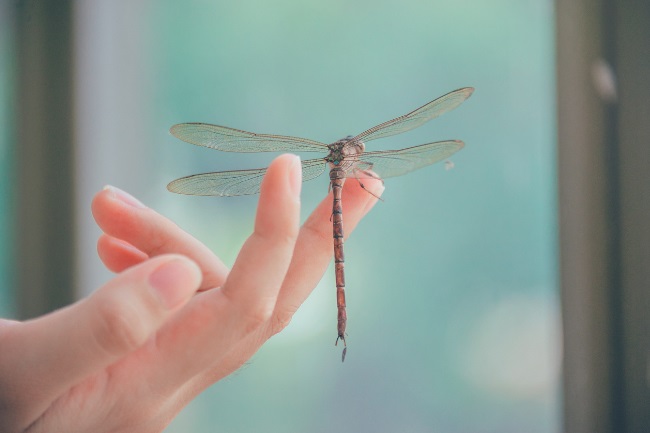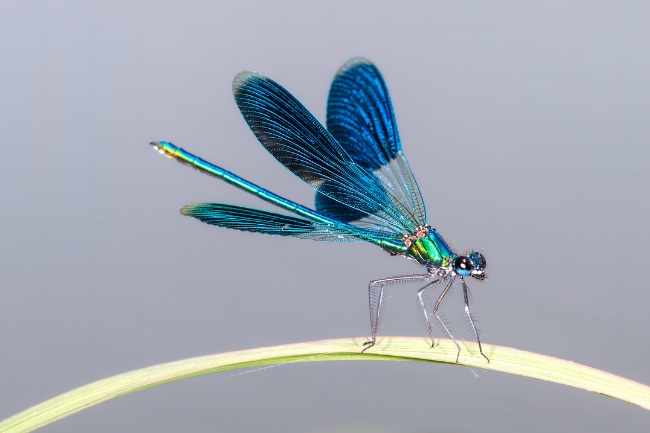Ponds are an excellent way to attract dragonflies to your garden, but if you don’t have the space to make one don’t despair, there are plenty of other ways to attract in these amazing insects. From planting dragonfly-friendly plants or creating a rain garden, there’s lots you can do.
Contents
Why attract dragonflies?

For many people, insects are all lumped into one big pile as undesirable and harmful. However, the large majority of insects are beneficial, helping to rid us of pests, pollinating our plants, or disposing of unwanted waste.
In our gardens, on our farms, and even in our cities, insects play important roles, and we must create places for them to feed and shelter, so they can continue to fulfill these roles.
Dragonflies can appear rather frightening to those not familiar with them. For one thing, they are often large and fly quickly above our heads. Some species are even curious and may zoom in to have a closer look at nearby humans. However, the good news is that they do not sting, and don’t bite humans.
The even better news is that dragonflies are voracious hunters, getting rid of many annoying pests that we would rather be without. Both as adults and as larvae they spend their time guzzling down mosquitoes, flies, and even ground dwelling species like ants.
By encouraging dragonflies into your garden you will reap the benefit of them taking care of many smaller invertebrates, and you will also get the pleasure of being able to observe these amazing aerial acrobatics dazzle you with their skill and brilliant colours.
So why wait?
How to attract dragonflies but not mosquitoes

The best way to attract dragonflies to your garden is to create a pond. Importantly it will need to be at least 2 feet deep to be suitable for the larvae to live within it. A pond has many benefits for other wildlife, such as birds that are able to drink from it.
However, there can be a negative side to have standing water in the garden. One of the biggest drawbacks can be to create a breeding ground for mosquitos. Mosquitos like stagnant water to breed in, meaning a simple way to avoid them taking up residence is to keep the water oxygenated. This can either be through the installation of a pump or fountain or by planting oxygenating plants.
| Plant Name | Common Name | Preferred Habitat |
|---|---|---|
| Purple Coneflower | Echinacea purpurea | Sunny areas, garden beds |
| Bee Balm | Monarda spp. | Moist areas, meadows |
| Swamp Milkweed | Asclepias incarnata | Wetlands, garden beds |
| Joe-Pye Weed | Eutrochium spp. | Moist areas, meadows |
| Blazing Star | Liatris spp. | Sunny areas, meadows |
However, there may be other reasons why you don’t want, or can’t have a pond in your garden. It may be that you simply don’t have the space. Or maybe you have concerns about health and safety. But whatever the reason there may be the good news is there are plenty of other options for attracting dragonflies into your garden.
Create a water feature
While a pond may not be possible you may be able to create a water feature. Water features can come in many forms and could be used by dragonflies in different ways.
Container ponds
Container ponds have many of the benefits of a pond without the hassle. Firstly they can take up less space and are ready-made. An old sink, an oak barrel or a steel trough can all be container ponds. These can be great for dragonflies, and depending on the size they may even breed in them. Even if it is too small to breed in, dragonflies may hunt above it.
A water bowl
A much smaller and simpler feature can be simply to fill a shallow bowl with water and place a large stone, or stones, in the centre. This will allow insects, such as dragonflies, to land on it and drink.
Bog gardens
Bogs are a fantastic habitat. Made up of mosses known as sphagnum and other specialist plants, they stay wet all year. Many dragonflies live in bog habitats, and you can create your own mini bog in a container, or directly in the ground by creating a shallow hole and lining it with a perforated pond liner, refilling the area with soil, and planting appropriately.
A rain garden
A rain garden is a fantastic feature for all kinds of reasons. This is an area where you create a shallow dip within your garden and direct rainwater into it, either through the use of slope or through swales and runnels. This allows the water to pool and then gradually seep away. It will prevent the water from flooding other areas during heavy rainfall and creates a temporary water feature. Such temporary pools can draw dragonflies into the garden out without having a permanently wet area, which may attract mosquitos.
Plant dragonflies attracting flowers

Dragonflies are not pollinators like bees and butterflies. This means that they don’t feed from flowers. Therefore plants that benefit dragonflies largely benefit them indirectly either by attracting in the insects they like to feed on, or by providing them places to perch and shelter.
If you opt to create a pond then marginal or aquatic vegetation is essential to provide shelter and perching places for your juvenile and adult dragonflies. Plants such as water lilies can be both attractive and useful to dragonflies. Sedges and rushes provide great cover around the edges for dragonflies to hide from predators.
| Attractant Type | Description |
|---|---|
| Water Feature | Small decorative water features, like a shallow birdbath or water fountain, can provide a water source for dragonflies. Place rocks or floating plants in the water for perching spots. |
| Native Vegetation | Plant native grasses, shrubs, and flowers in your yard. These provide perching spots, shelter, and food sources for dragonflies. |
| Insect-Friendly Yard | Create a welcoming environment for insects, such as leaving some areas of your yard untamed, allowing wildflowers to grow, and avoiding the use of pesticides. This attracts prey insects, which in turn attract dragonflies. |
Aside from aquatic plants, the best plants are those that are beloved by other insects. Many garden centres will now mark plants are being particularly beneficial for pollinators, however here are a few handy tips;
- Choose plants that are native to your region. While non-native plants can still benefit insects, native plants are more likely to support a larger number of native insect species.
- Choose flowers that are open, without multiple petals. Many ornamental plants have been bred to look fantastic with many layers of petals. However, for many of these, there’s no way for insects to actually get in and feed on the nectar and pollen, making them effectively useless to pollinators.
- Choose flowers for all times of the year. Having flowers that provide food right through the year can help attract more insects and support them at times when there might be little else around, such as in the spring and autumn.
- Choose plants that provide food for larvae. We often only think about the adult stages of the insects, such as butterflies, hoverflies and beetles. Yet they all come from caterpillars, larvae and grubs, which often have very different habitat requirements. Many feed on grasses or rotting wood. Some may live in the soil or nibble at the leaves of your favourite flowers. In order to ensure there are plenty of adults around you also need to be providing plenty to eat for their young.
Some examples of great insect attractive flowers;
- Sunflowers
- Michaelmas daisy
- Nastrium
- Fennel
- Lavender
- Mint
- Foxgloves
- Fleabane
Also read: What Does a Dragonfly Eat and Drink? (Habits Explained)
Stop using pesticides
When you’ve got holes in your vegetable and wilting flower buds it can be very tempting to reach straight for the pesticides, however, not all insects in your garden are out to get you. Many are beneficial, such as pollinators. Pesticides will kill indiscriminately and you will soon find you are losing the good along with the bad. In time this can mean that those species that eat the pests disappear and the pest species begin to dominate.
Dragonflies will happily visit your garden if you’ve got plenty to eat, but there’s really no point if you’ve killed off all their tasty snacks.
How to spot dragonflies
The good news is that dragonflies aren’t too difficult to spot once you’ve attracted them in. Because of their size, they tend to be very noticeable. Although they can be difficult to get a good look at when they are flying they will often perch on vegetation, giving time for you to fix your sight on them. Looking through binoculars can be a useful tip as approaching too close can cause them to fly off.
Additionally many will roost in vegetation in the evening and overnight, giving more of an opportunity to observe them. So keep your eyes open and you never know you might have a chance to spot them.

